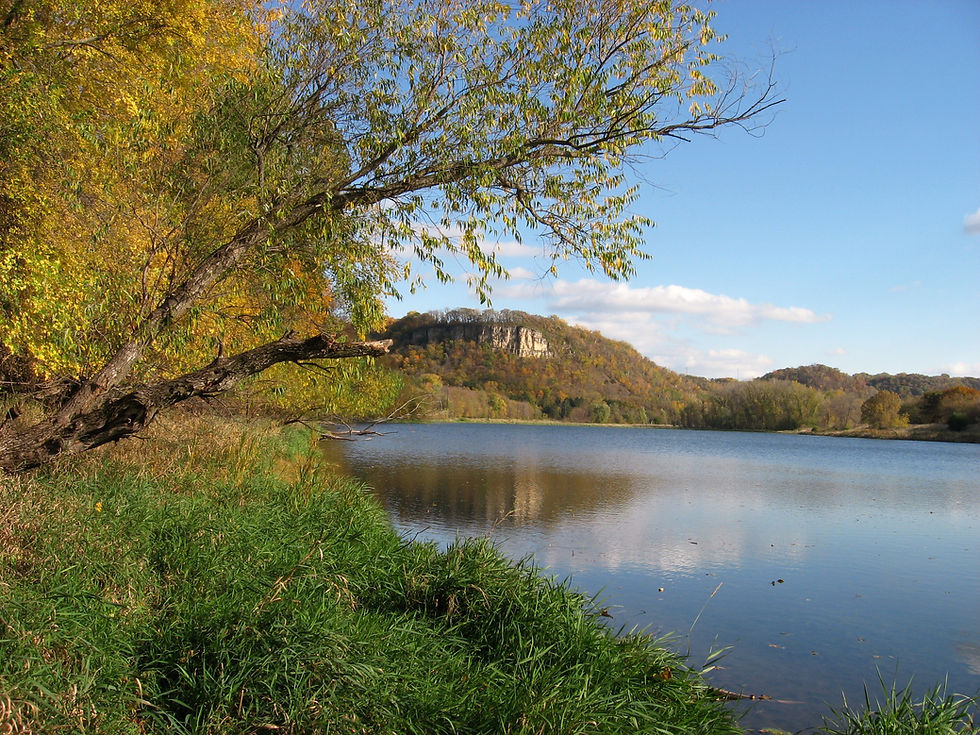The Circle of Life
- Bruce Ause
- Jul 1, 2018
- 3 min read

Purple Prairie Clover and Orange Coneflower
For the past several years, there have been some very dedicated residents and members of the Friends Of Wacouta who have worked tirelessly to restore a prairie along the edge of the Rattlesnake bluff trail. Three members of this group who have gone above and beyond in their efforts are Nancy Braschler, Diane Mueller and Jill Mehrkens. This prairie is a beautiful enhancement to the trail and is appreciated by many people. This morning I went for a bike ride and identified the following native prairie plants. The prairie is near peak bloom, so take advantage of this wonderful opportunity.
Flowering Spurge
Rattlesnake-Masters
Daisy Fleabane
Black-Eyed Susan
Gray-Headed Coneflower
Woodland Sunflower
Butterfly Weed
Wild Bergamot
Purple Prairie Clover
White Prairie Clover
Common Milkweed
Swamp Milkweed
Purple Coneflower
Orange Coneflower
Spiderwort

Monarch Larvae
One of the benefits of the previously mentioned efforts has been the enhancement of the local habitat for pollinators and butterflies. In the early morning of May 14th as I was walking along the trail paralleling Lakeview Ave., I observed a single butterfly weed plant (Asclepias tuberosa) hosting 7 monarch butterfly larvas.

Western Fox Snake in a Crab Apple Tree on a Robin's Nest
As we were finishing breakfast on Friday morning June 15th, we noticed some strange behavior by a variety of birds hovering over our small crab apple tree. Six orioles, four robins, two catbirds and tree goldfinches were frantically diving into the tree and making very loud calls. Kathy mentioned to me "you don't suppose there might be a snake up in the tree"? I grabbed my camera and quickly headed out the door to inspect the situation. What I discovered was a 5 to 6 foot long fox snake wound around a new robin's nest.

Western Fox Snake and Robin Nestling
The snake had evidently already consumed 3 nestlings and had number 4 in the grasp of it's jaws. The most remarkable aspect of this experience was having 4 different bird species working together to solve a problem.

Male Eastern Tiger Swallowtail Butterfly and Milkweed Flower
With copious amounts of rain the past month, there has been the production of a bumper crop of common milkweeds. As this photo documents, the milkweed plant and flowers are a valuable source of food to a number of butterflies including monarchs and swallowtails. The tiger swallowtail is one of the most familiar butterflies in our area. It is commonly found in forests and along streams, but is also at home in our backyards.

Female Ruby-Throated Hummingbird
In recent weeks, we have had up to eight different ruby-throated hummingbirds visiting our nectar feeders. Try as we might, we have yet to locate the secretive nests in our yard. That is why I became very excited to receive a call from a friend, Lisa Johnson, informing me that she had an active hummingbird nest just outside her living room window. I have made a concerted effort to limit my blog photos to those taken only in Wacouta township. Unfortunately, one of the challenges I face is that Wacouta has only 5 partial sections where as most townships have 36. So to be honest with my readers, this photo was taken outside Wacouta and in Hay Creek township. Hopefully as the nesting moves forward, I will have a couple other photos to share in the next post.

Female Great Crested Flycatcher
On the morning of Monday June 17th, we noticed a considerable amount of activity going in and coming out of one of our backyard wood duck nesting boxes. Upon closer examination with a pair of binoculars, we discovered the bird in question was a Great Crested Flycatcher.

Flycatcher with Nesting Material
Great Crested Flycatchers are primarily woodland birds and are known as sit and wait predators. They dive from high perches after rather large insects and then return to the same or a nearby perch with their quarry.

Nesting Box Backfilled
These flycatchers nest in cavities created by woodpeckers. The cavities are usually created in dead trees, hollow posts and can be as high as 70 feet above the ground. In the case of selecting a cavity in a wood duck box, the female will back fill the box raising the level several inches with debris to help the young nestlings to exit the box. Materials used for this purpose might include grass, leaves, twigs, pine needles and even cellophane.




Comments